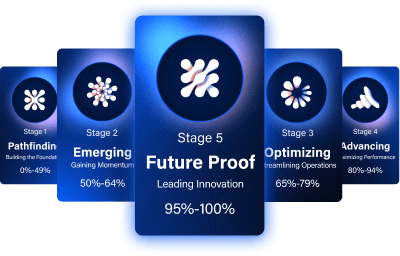What’s the first type of software that comes to mind when you think “accounting”? Maybe it has to do with financial management or client management. But productivity tools are just as important, if not more so. They enable a firm’s profitability and long-term success. (Cue the old adage: “Work smarter, not harder.”)
Streamlining workflows using the right solutions ensures you’re spending less time on manual tasks. In turn, you have more time to focus on what matters: growing your firm.
In this post, discover the best productivity tools and technologies modern firms are using to work more efficiently. Let’s dive in.
Top 7 productivity tools for accountants
1. The cloud
The first type of productivity tool that ALL accountants must deploy is a cloud hosting environment.
Cloud hosting environments enable firms to:
- Maintain secure information: Look for a provider offering protections such as multifactor authentication, multi-layered firewalls and malware detection.
- Work from a more reliable infrastructure: A reputable hosting provider will house data in multiple, top-tier data centers that are geographically diverse.
- Connect and collaborate more easily: Improve workflows and productivity by collaborating with colleagues and clients in one hosted environment—anytime, anywhere.
Flexibility is the key to success. The ability to work from anywhere is now a necessity in the modern workforce.
To keep sensitive information secure, host data in a secure, compliant and reliable environment.
2. Communication tools
The next best thing to have in your accounting toolbelt is an effective way to communicate with colleagues.
Look for a cloud-based application stack that includes communication tools such as Microsoft 365. Integrated, easy-to-use communication apps keep teams productive by ensuring they don’t miss a single task, commitment or communication.
How? First and foremost, the apps are cloud-based. They allow you to pick up where you left off from anywhere. Need to reschedule a meeting when you’re away from your computer? Pick up your phone and do it in Microsoft 365. Think of a question you need to get answered immediately? Chat with your colleagues in the Teams app.
To optimize your workflows, look for communication tools with features such as:
- Centralized storage
- File access and collaboration
- Videoconferencing
- Secure email
- Chat
3. Cloud accounting applications
Next up? Cloud accounting applications, which fall into two categories:
- Applications that can be hosted in the cloud
- Applications that are already cloud-based (available via web browser)
Firms come in different shapes and sizes, have varying needs, and require different types of accounting software.
You need to find a provider that hosts more than one accounting application, so you don’t have to make any software switches.
Learn more about what Right Networks offers for a variety of hosted applications:
4. Document management
Sharing documents and files securely and efficiently is crucial. Document management tools such as SmartVault can save you many hours each month by automating manual, paper-based tasks and creating standardized workflows, as well as giving your firm a client portal to store all your clients’ files in one central location.
5. Collaboration tools
The ability for your employees to work on the same documents simultaneously is critical for effective collaboration. Look for collaboration tools that allow comments, notes, tagging and the ability to work on documents simultaneously to help your team members complete client work faster.
6. Time-tracking tools
If you track billable hours, as just about all accounting firms do, you need time–tracking software that’s automated and easy to use. When looking for a time–tracking application, look for one that lets you track in a timer, differentiate between billable and non-billable time, and categorize time entries. Also, make sure the app has strong reporting capabilities.
7. Organization tools
Effective project management is just as important to productivity as communication and collaboration. Organizational tools that assist with project management allow you to keep your projects organized and ensure you always have easy access to the information you need.
Key data can include links to important documents, as well as goals, checklists and even due dates. Look for organizational tools that allow you to set up projects, add due dates, integrate key client information and have an at-a-glance view of project status.
Work smarter with productivity tools for accountants
There’s a lot of information you must keep up with on a day-to-day basis to ensure your firm is running smoothly, efficiently and productively. Tools that will help give you time back in your day, week and year are becoming a necessity rather than something that’s just nice to have.
Each firm has specific needs, and it’s important to ensure you are evaluating where you are spending the most time and optimizing your workflow accordingly. Start by checking out essential tools and technologies, including QuickBooks®, Microsoft 365 and SmartVault, to help you boost your productivity and profitability.
For more productivity tips, subscribe to our blog today.


